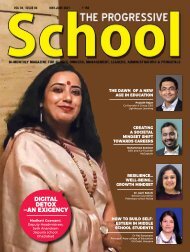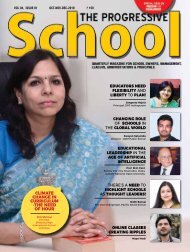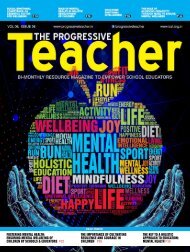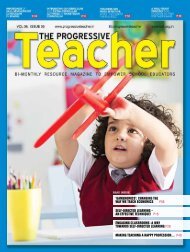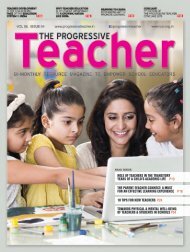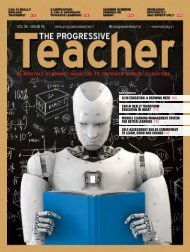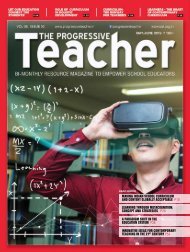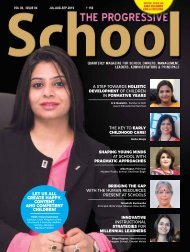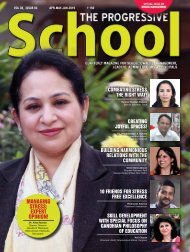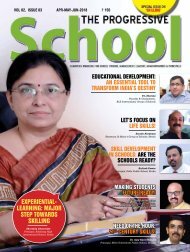The Progressive Teacher Vol 03 Issue 05
This issue of The Progressive Teacher focuses on "Teaching of Social Studies". The magazine provides guidance to the teachers by their peers and school leaders for tackling challenges with innovative ideas.
This issue of The Progressive Teacher focuses on "Teaching of Social Studies". The magazine provides guidance to the teachers by their peers and school leaders for tackling challenges with innovative ideas.
Create successful ePaper yourself
Turn your PDF publications into a flip-book with our unique Google optimized e-Paper software.
teaching<br />
What is the<br />
purpose of<br />
your lesson?<br />
Did your students<br />
actually ‘get it’?<br />
–Eric Bransteter<br />
Why, exactly, are students spending time with you today? What is it you want students to<br />
know, understand, and be able to do as a result of this lesson and unit?<br />
Great teaching starts with a great<br />
reason to teach!<br />
My favorite analogy to describe<br />
learning objectives (or lesson<br />
objectives, learning targets, learning<br />
goals, etc.) is to think about a GPS system.<br />
Unless you are on summer break, it is not<br />
often that you get in your car and just<br />
start driving. It’s even less often that you<br />
get in your car and the car decides to take<br />
you somewhere. Instead, you take about<br />
30 seconds and type in your destination.<br />
Magically, the GPS system gives you turn<br />
by turn directions, and you can even look at<br />
the route in advance to know why the GPS<br />
system is taking you in a certain way. Is<br />
there an accident on your typical route?<br />
Perhaps a road is closed? And what happens<br />
when you miss a turn or make a pit stop?<br />
You receive specific and targeted feedback on<br />
how to stay on course. Voila, you are at your<br />
destination!<br />
How does this translate to the classroom?<br />
Clear and specific (measurable even?) lesson<br />
objectives, teamed with effective checks for<br />
understanding and modifying instruction as<br />
needed, allow for students to know where<br />
they are going and when they have arrived.<br />
Without a ‘road map’ giving directions and<br />
feedback along the way, there is no ending.<br />
Students will never know if they’ve gotten<br />
anywhere, let alone their destination. What’s<br />
just as important is the why.<br />
Do students also know why they are<br />
spending time in school learning this?<br />
Do they understand the significance and<br />
real-world application of the concepts being<br />
taught?<br />
As simple as this sounds, the magic of these<br />
clear and specific lesson objectives comes<br />
from the teacher communicating them to the<br />
students. Make it no secret – the students<br />
should know precisely what they are<br />
doing and why it is important. Be explicit,<br />
and your students will take ownership of the<br />
learning themselves.<br />
One simple and effective way of gauging<br />
how well students understand the purpose<br />
Eric is the President and CEO of iAspire. He has 10 years<br />
experience in education as a teacher, media specialist, and<br />
most recently as an elementary administrator. Eric recently<br />
received a Miller Legacy Award by his former students,<br />
an award given by the current graduating class to honor<br />
educators who made a significant influence on their lives.<br />
Eric engages educators in a process of needs identification<br />
and plans for long-term, sustained success through iAspire.<br />
of the lesson is to ask them! As an<br />
administrator, I made it routine at the<br />
end of each observation to ask a few<br />
students what they were doing and why.<br />
I typically wrote the students’ answers<br />
in the feedback I sent teachers so they<br />
could read their students’ comments. <strong>The</strong><br />
student comments became an important<br />
part of my post-observation conversation<br />
with teachers. If students are able to<br />
articulate the day’s learning, its impact,<br />
and its importance, there was clarity. If<br />
students could not, it was time for me to<br />
ask more questions of the teacher to better<br />
understand why this might be.<br />
<strong>Teacher</strong>s can ask the exact same question<br />
at the end of a lesson, either as a quick exit<br />
slip, a short dialogue, or in some other way.<br />
Are you allowing your students to know<br />
their final destination before even<br />
beginning the lesson, or are you having<br />
your students jump into the car without<br />
any idea of where they are going?<br />
8 <strong>The</strong> <strong>Progressive</strong> <strong>Teacher</strong> Nov/Dec 2016




